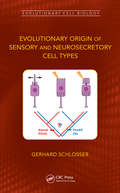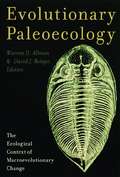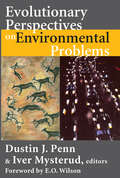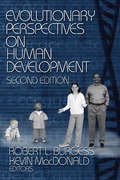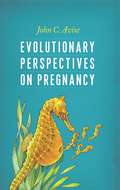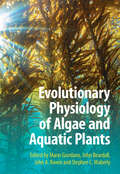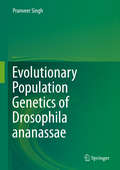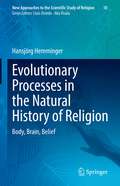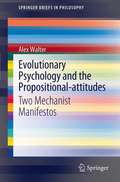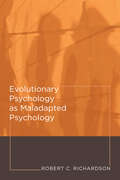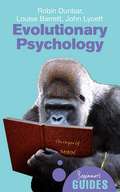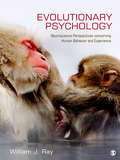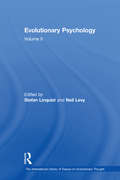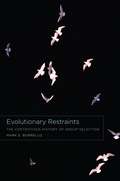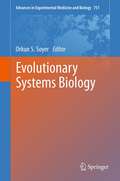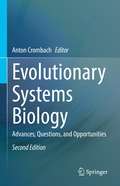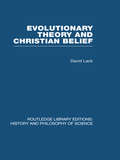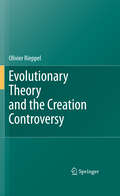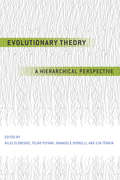- Table View
- List View
Evolutionary Origin of Sensory and Neurosecretory Cell Types: Vertebrate Cranial Placodes, volume 2 (Evolutionary Cell Biology)
by Gerhard SchlosserMost vertebrate cranial sense organs arise from placodes. These placodes give rise to sensory neurons that transmit information to the brain and neurosecretory cells. This book reviews the evolutionary origin of the sensory and neurosecretory cell types. It summarizes our current understanding of vertebrate evolution, clarifies conceptual issues relating to homology and evolutionary innovation of cell types, compares the sensory and neurosecretory cell types with similar cell types in other animals, and addresses the question of how cranial placodes evolved as novel structures in vertebrates by redeploying pre-existing and sometimes evolutionarily ancient cell types.
Evolutionary Paleoecology: The Ecological Context of Macroevolutionary Change
by David J. Bottjer Eds. Allmon WarrenOne of the most important questions we can ask about life is "Does ecology matter?" Most biologists and paleontologists are trained to answer "yes," but the exact mechanisms by which ecology matters in the context of patterns that play out over millions of years have never been entirely clear. This book examines these mechanisms and looks at how ancient environments affected evolution, focusing on long-term macroevolutionary changes as seen in the fossil record.Evolutionary paleoecology is not a new discipline. Beginning with Darwin, researchers have attempted to understand how the environment has affected evolutionary history. But as we learn more about these patterns, the search for a new synthetic view of the evolutionary process that integrates species evolution, ecology, and mass extinctions becomes ever more pressing. The present volume is a benchmark sampler of active research in this ever more active field.
Evolutionary Paleoecology: The Ecological Context of Macroevolutionary Change
by David J. Bottjer Warren AllmonOne of the most important questions we can ask about life is "Does ecology matter?" Most biologists and paleontologists are trained to answer "yes," but the exact mechanisms by which ecology matters in the context of patterns that play out over millions of years have never been entirely clear. This book examines these mechanisms and looks at how ancient environments affected evolution, focusing on long-term macroevolutionary changes as seen in the fossil record. Evolutionary paleoecology is not a new discipline. Beginning with Darwin, researchers have attempted to understand how the environment has affected evolutionary history. But as we learn more about these patterns, the search for a new synthetic view of the evolutionary process that integrates species evolution, ecology, and mass extinctions becomes ever more pressing. The present volume is a benchmark sampler of active research in this ever more active field.P.K. Strother, Choice
Evolutionary Perspectives on Environmental Problems
by E. O. Wilson Dustin J. Penn Iver MysterudThe twenty-first century presents an increasing number of environmental problems, including toxic pollution, global warming, destruction of tropical forests, extinction of biological diversity, and depletion of natural resources. These environmental problems are generally due to human behavior, namely over-consumption of resources and overpopulation. Designing effective policies to address these problems requires a deep understanding of human behavior as well as ecology. This in turn requires considerations of human nature, and the evolutionary "design" of the human mind.Evolutionary research on human behavior has profound implications for the environmental sciences. The aim of this collection is to bring together a variety of chapters that show how and why. Part 1, "Human Nature and Resource Conservation," addresses environmental problems from different evolutionary perspectives. Part 2, "The Ecological Noble Savage Hypothesis," examines the notion that our environmental problems are due to Western culture, and that our ancestors and people in indigenous societies lived in harmony with nature until the corrupting influences of Western culture. Part 3, "The Tragedy of the Commons," explores the conservation of common-pool or open-access natural resources, such as fisheries, forests, grazing lands, freshwater, and clean air. Part 4, "The Evolution of Discounting and Conspicuous Consumption," looks at the problem of explaining why people are so ecologically short-sighted and why people in developed countries consume so many resources. Part 5, "Overpopulation and Fertility Declines," addresses the evolution of human reproductive decisions. Part 6, "Biophilia," aims to explain why people cherish nature as well as destroy it.The goal of this volume is to introduce environmental thinkers to evolutionary perspectives on human behavior, and the new interdisciplinary sciences of evolutionary psychology and behavioral ecology. This reader aims to help bridge
Evolutionary Perspectives on Human Development
by Robert Lee Burgess Kevin MacDonaldEvolutionary Perspectives on Human Development, Second Edition considers the role of evolutionary theory in the field of developmental psychology to examine key topics of individual human development. This unique book fills an important gap in the literature, applying evolutionary models to human development by focusing on central development issues. The book emphasizes both domain-general evolved psychological mechanisms and domain-specific processes. The text also integrates behavior-genetic research with evolutionary and developmental principles. Evolutionary Perspectives on Human Development provides state-of-the-art groundwork in evolutionary theory as viewed by leading thinkers in the field.
Evolutionary Perspectives on Pregnancy
by John AviseCovering both the internal and external incubation of offspring, this book provides a biology-rich survey of the natural history, ecology, genetics, and evolution of pregnancy-like phenomena. From mammals and other live-bearing organisms to viviparous reptiles, male-pregnant fishes, larval-brooding worms, crabs, sea cucumbers, and corals, the world's various species display pregnancy and other forms of parental devotion in surprisingly multifaceted ways. An adult female (or male) can incubate its offspring in a womb, stomach, mouth, vocal sac, gill chamber, epithelial pouch, backpack, leg pocket, nest, or an encasing of embryos, and by studying these diverse examples from a comparative vantage point, the ecological and evolutionary-genetic outcomes of different reproductive models become fascinatingly clear. John C. Avise discusses each mode of pregnancy and the decipherable genetic signatures it has left on the reproductive structures, physiologies, and innate sexual behaviors of extant species. By considering the many biological aspects of gestation from different evolutionary angles, Avise offers captivating new insights into the significance of "heavy" parental investment in progeny.
Evolutionary Perspectives on Pregnancy
by John C. AviseCovering both the internal and external incubation of offspring, this book provides a biology-rich survey of the natural history, ecology, genetics, and evolution of pregnancy-like phenomena.
Evolutionary Physiology of Algae and Aquatic Plants
by John Beardall Mario Giordano John A. Raven Stephen C. MaberlyPhotosynthetic organisms have an enormous influence on our environment through their effects on the development of other life on Earth and the way they alter the planet's geology and geochemistry. This book takes a unique approach by examining the evolutionary history of the major groups of aquatic photoautotrophs in the context of the ecophysiological characteristics that have allowed them to adapt to the challenges of life in water and thrive under past and present environmental conditions. The important role played by aquatic photoautotrophs on a planet undergoing unprecedented anthropogenic-induced change is also highlighted, in chapters on their critical function in mitigating environmental change through their physiological processes, and on the role of algae in biotechnology. This invaluable resource will be appreciated by researchers and advanced students interested in the biodiversity and evolutionary physiology of the full range of aquatic photoautotrophs, and their interaction with the environment.
Evolutionary Population Genetics of Drosophila ananassae
by Pranveer SinghThis book introduces readers to classical population genetics and the ways in which it can be applied to practical problems, including testing for natural selection, genetic drift, genetic differentiation, population structuring, gene flow and linkage disequilibrium. It provides a comprehensive monograph on the topic, addressing the theory, applications and evolutionary deductions, which are clearly explained using experimental results. It also offers separate chapters on origin, establishment and spread of chromosomal aberrations in populations along with details of culturing, maintaining and using Drosophila ananassae (genetically unique and the most commonly used species along with D. melanogaster) for genetic research. Encompassing topics like genetics, evolution, Drosophila genetics, population genetics, population structuring, natural selection and genetic drift in considerable detail, it provides a valuable resource to undergraduate and postgraduate students, as well as researchers at all level. This book explores some fundamental questions concerning the role of natural selection and genetic drift on the degree of inversion polymorphism. India, with its wide diversity in geo-climatic conditions, provides an excellent platform to conduct such studies. The book showcases sampling records of inversion frequencies in natural Indian populations of D. ananassae that cover more than two decades. It highlights case studies in which sampling data on inversion frequencies was combined with that from earlier surveys, generating a time series that allows the evolutionary dynamics of inversion polymorphism to be explored. Such long time series are rare but nonetheless crucial for studying the evolutionary dynamics of inversion polymorphism. The population-genetic analysis discussed is unprecedented in terms of its temporal (two decades) and spatial (most regions of India covered) scale and investigates the patterns of polymorphic system in D. ananassae to see if there is any temporal divergence. It endeavors to present a holistic picture of inversion polymorphism across the country (India). Chromosomal aberrations, particularly paracentric inversions, are used as a tool for discussing population genetic studies, helping human geneticists, gynecologists and other medical professionals understand why some aberrations are fatal in humans, with affected embryos often not surviving the first trimester of pregnancy, while similar aberrations in Drosophila flies aid in their adaptation to the environmental heterogeneity across the globe.
Evolutionary Processes in the Natural History of Religion: Body, Brain, Belief (New Approaches to the Scientific Study of Religion #10)
by Hansjörg HemmingerThe study of religion by the humanities and social sciences has become receptive for an evolutionary perspective. Some proposals model the evolution of religion in Darwinian terms, or construct a synergy between biological and non-Darwinian processes. The results, however, have not yet become truly interdisciplinary. The biological theory of evolution in form of the Extended Evolutionary Synthesis (EES) is only sparsely represented in theories published so far by scholars of religion. Therefore this book reverses the line of view and asks how their results assort with evolutionary biology:How can the subject area “religion” integrated into behavioral biology?How is theory building affected by the asymmetry between the scarce empirical knowledge of prehistoric religion, and the body of knowledge about extant and historic religions?How does hominin evolution in general relate to the evolution of religion? Are there evolutionary pre-adaptations?Subsequent versions of evolutionary biology from the original Darwinism to EES are used in interdisciplinary constructs. Can they be integrated into a comprehensive theory?The biological concept most often used is co-evolution, in form of a gene-culture co-evolution. However, the term denotes a process different from biological co-evolution.Important EES concepts do not appear in present models of religious evolution: e.g. neutral evolution, evolutionary drift, evolutionary constraints etc. How to include them into an interdisciplinary approach?Does the cognitive science of religion (CSR) harmonize with behavioral biology and the brain sciences?Religion as part of human culture is supported by a complex, multi-level behavioral system. How can it be modeled scientifically? The book addresses graduate students and researchers concerned about the scientific study of religion, and biologist interested in interdisciplinary theory building in the field.
Evolutionary Psychology
by Lance Workman Will ReaderEvolutionary psychology starts from the premise that the human brain is the product of natural selection; therefore, by adopting an evolutionary stance, we might come to better understand the mind and behaviour. The second edition of this highly acclaimed textbook gives an introduction to the fascinating science of evolutionary psychology covering its history, from the Ancient Greeks to the present day, and discusses how evolution can illuminate many of the topics taught in psychology departments. This new edition, now in 2 colour, includes an additional chapter on 'Evolution and Individual Differences' which discusses how evolution might account for differences in personality and intelligence. With an engaging style and user-friendly format featuring end-of-chapter summaries, critical thinking questions and guides to further reading, this is a stand-alone textbook for undergraduates studying evolutionary psychology.
Evolutionary Psychology and the Propositional-attitudes
by Alex WalterThe two essays provide a critical examination of theory and research in the field of evolutionary psychology. The view advanced here is that philosophical materialism and minimalist assumptions about adaptation serve Darwinian psychology better than the more popular alternative view that relies on cognitive dualism and propositional-attitude psychology to formulate evolutionary psychology theory. A commitment to cognitive dualism is destined to undermine the physical basis of behavior upon which evolutionary theory depends. Many evolutionary psychologists do not see this but are seduced by the easy way in which hypotheses can be formulated using the 'propositional-attitude' model. The challenge is to develop a materialistic and mechanistic approach to understanding human cognition and behavior, including linguistic and social behavior.
Evolutionary Psychology and the Propositional-attitudes: Two Mechanist Manifestos (SpringerBriefs in Philosophy)
by Alex WalterThe two essays provide a critical examination of theory and research in the field of evolutionary psychology. The view advanced here is that philosophical materialism and minimalist assumptions about adaptation serve Darwinian psychology better than the more popular alternative view that relies on cognitive dualism and propositional-attitude psychology to formulate evolutionary psychology theory. A commitment to cognitive dualism is destined to undermine the physical basis of behavior upon which evolutionary theory depends. Many evolutionary psychologists do not see this but are seduced by the easy way in which hypotheses can be formulated using the ‘propositional-attitude’ model. The challenge is to develop a materialistic and mechanistic approach to understanding human cognition and behavior, including linguistic and social behavior.
Evolutionary Psychology as Maladapted Psychology (Life and Mind: Philosophical Issues in Biology and Psychology)
by Robert C. RichardsonA philosopher subjects the claims of evolutionary psychology to the evidential and methodological requirements of evolutionary biology, concluding that evolutionary psychology's explanations amount to speculation disguised as results.Human beings, like other organisms, are the products of evolution. Like other organisms, we exhibit traits that are the product of natural selection. Our psychological capacities are evolved traits as much as are our gait and posture. This much few would dispute. Evolutionary psychology goes further than this, claiming that our psychological traits—including a wide variety of traits, from mate preference and jealousy to language and reason—can be understood as specific adaptations to ancestral Pleistocene conditions. In Evolutionary Psychology as Maladapted Psychology, Robert Richardson takes a critical look at evolutionary psychology by subjecting its ambitious and controversial claims to the same sorts of methodological and evidential constraints that are broadly accepted within evolutionary biology.The claims of evolutionary psychology may pass muster as psychology; but what are their evolutionary credentials? Richardson considers three ways adaptive hypotheses can be evaluated, using examples from the biological literature to illustrate what sorts of evidence and methodology would be necessary to establish specific evolutionary and adaptive explanations of human psychological traits. He shows that existing explanations within evolutionary psychology fall woefully short of accepted biological standards. The theories offered by evolutionary psychologists may identify traits that are, or were, beneficial to humans. But gauged by biological standards, there is inadequate evidence: evolutionary psychologists are largely silent on the evolutionary evidence relevant to assessing their claims, including such matters as variation in ancestral populations, heritability, and the advantage offered to our ancestors. As evolutionary claims they are unsubstantiated. Evolutionary psychology, Richardson concludes, may offer a program of research, but it lacks the kind of evidence that is generally expected within evolutionary biology. It is speculation rather than sound science—and we should treat its claims with skepticism.
Evolutionary Psychology: A Beginner's Guide (Beginner's Guides)
by Louise Barrett Robin Dunbar John LycettStarting with its origins in the work of Charles Darwin, the book covers all the key areas of evolutionary psychology, including the role played by genetics in our sexual behavior, parental decision-making, and how babies learn about and adapt to the world.
Evolutionary Psychology: Neuroscience Perspectives concerning Human Behavior and Experience
by William J. RayMany books in evolutionary psychology emphasize just a small part of the total picture. Evolutionary Psychology gives students a clear understanding of how current psychological knowledge of human behavior and experience draws from a variety of perspectives. It begins with an understanding of evolution and the close connection between organisms and their environment. It provides the student the basics necessary to see how the environment and the turning on and off of genes can influence humans and the cultures in which they live. The book shows that we solve certain problems of life as many species have done for years. It also shows a glimpse of human abilities not seen in other species. We use language. We purposely teach our children. We build large cities that survive long after a single generation. We create cultures that through their writings and art can influence other humans thousands of years later. Current research in social processes, decision making, and brain imaging is presented in a clear manner throughout the book. The book emphasizes developmental processes and family relationships, sexual and social relationships, as well as emotionality and language. The book concludes by applying an evolutionary understanding approach to examine the areas of health and disease, psychopathology, and culture.
Evolutionary Psychology: Volume II (The International Library of Essays on Evolutionary Thought)
by Neil LevyEvolutionary approaches to the study of human beings have been able to explain the origin and maintenance of many of the features of our bodies. Many thinkers believe that an evolutionary approach will be equally fruitful when it comes to explaining the features of our minds. Since our behaviour is driven by our minds, our cognitive dispositions and processes are likely to have been a target of selection and adaptation. This volume collects recent prominent explorations of this theme, as well as the voices of dissenters who argue that our minds are far more significantly the product of culture than of evolution.
Evolutionary Restraints: The Contentious History of Group Selection
by Mark E. BorrelloMuch of the evolutionary debate since Darwin has focused on the level at which natural selection occurs. Most biologists acknowledge multiple levels of selection--from the gene to the species. The debate about group selection, however, is the focus of Mark E. Borrello's Evolutionary Restraints. Tracing the history of biological attempts to determine whether selection leads to the evolution of fitter groups, Borrello takes as his focus the British naturalist V. C. Wynne-Edwards, who proposed that animals could regulate their own populations and thus avoid overexploitation of their resources. By the mid-twentieth century, Wynne-Edwards became an advocate for group selection theory and led a debate that engaged the most significant evolutionary biologists of his time, including Ernst Mayr, G. C. Williams, and Richard Dawkins. This important dialogue bled out into broader conversations about population regulation, environmental crises, and the evolution of human social behavior. By examining a single facet in the long debate about evolution, Borrello provides powerful insight into an intellectual quandary that remains relevant and alive to this day.
Evolutionary Restraints: The Contentious History of Group Selection
by Mark E. BorrelloMuch of the evolutionary debate since Darwin has focused on the level at which natural selection occurs. Most biologists acknowledge multiple levels of selection—from the gene to the species. The debate about group selection, however, is the focus of Mark E. Borrello’s Evolutionary Restraints. Tracing the history of biological attempts to determine whether selection leads to the evolution of fitter groups, Borrello takes as his focus the British naturalist V. C. Wynne-Edwards, who proposed that animals could regulate their own populations and thus avoid overexploitation of their resources. By the mid-twentieth century, Wynne-Edwards became an advocate for group selection theory and led a debate that engaged the most significant evolutionary biologists of his time, including Ernst Mayr, G. C. Williams, and Richard Dawkins. This important dialogue bled out into broader conversations about population regulation, environmental crises, and the evolution of human social behavior. By examining a single facet in the long debate about evolution, Borrello provides powerful insight into an intellectual quandary that remains relevant and alive to this day.
Evolutionary Systems Biology
by Orkun S. SoyerThe book aims to introduce the reader to the emerging field of Evolutionary Systems Biology, which approaches classical systems biology questions within an evolutionary framework. An evolutionary approach might allow understanding the significance of observed diversity, uncover "evolutionary design principles" and extend predictions made in model organisms to others. In addition, evolutionary systems biology can generate new insights into the adaptive landscape by combining molecular systems biology models and evolutionary simulations. This insight can enable the development of more detailed mechanistic evolutionary hypotheses.
Evolutionary Systems Biology: Advances, Questions, and Opportunities
by Anton CrombachThis new edition captures the advances made in the field of evolutionary systems biology since the publication of the first edition. The first edition focused on laying the foundations of evolutionary systems biology as an interdisciplinary field, where a way of thinking and asking questions is combined with a wide variety of tools, both experimental and theoretical/computational. Since publication of the first edition, evolutionary systems biology is now a well-known term describing this growing field. The new edition provides an overview of the current status and future developments of this interdisciplinary field. Chapters highlight several key achievements from the last decade and outline exciting new developments, including an understanding of the interplay between complexity and predictability in evolutionary systems, new viewpoints and methods to study organisms in evolving populations at the level of the genome, gene regulatory network, and metabolic network, and better analysis and modeling techniques that will open new avenues of scientific inquiry.
Evolutionary Systems and Society: A General Theory
by Vilmos CsányiThis work is a bold new effort to embrace all aspects of life--molecular, cellular, behavioral, and cultural--within the formulation of a general theory of evolution that extends classical Darwinian theory to include human society.
Evolutionary Theory and Christian Belief: The Unresolved Conflict (Routledge Library Editions: History & Philosophy of Science)
by David LackOriginally published in 1957. This book is concerned with the conflict between "Darwinism" as the Victorians called it, and Christianity, a conflict here re-stated in modern terms because it so vitally affects our understanding of human nature and human values today. The opening chapter describes the historical background. There is a short account of evolution and the argument over Genesis. The importance of natural selection is stressed, and rival theories as to the means of animal evolution are criticised. Discussions follow on whether the course of evolution has been random or determined, on the argument from design, death in nature, the biologist’s methods and the difficulties in evolutionary ethics.
Evolutionary Theory and the Creation Controversy
by Olivier RieppelEvolutionary theory addresses the phenomenon of the origin and diversity of plant and animal species that we observe. In recent times, however, it has become a predominant ideology which has gained currency far beyond its original confines. Attempts to understand the origin and historical development of human culture, civilization and language, of the powers of human cognition, and even the origin of the moral and ethical values guiding and constraining everyday life in human societies are now cast in an evolutionary context. In "Evolutionary Theory and the Creation Controversy" the author examines evolutionary theory from a historical perspective, explaining underlying metaphysical backgrounds and fundamental philosophical questions such as the paradoxical problem of change, existence and creation. He introduces the scientists involved, their research results and theories, and discusses the evolution of evolutionary theory against the background of Creationism and Intelligent Design.
Evolutionary Theory: A Hierarchical Perspective
by Telmo Pievani Emanuele Serrelli Niles Eldredge, Telmo Pievani, Emanuele Serrelli, and Ilya Tëmkin Ilya TëmkinThe natural world is infinitely complex and hierarchically structured, with smaller units forming the components of progressively larger systems: molecules make up cells, cells comprise tissues and organs that are, in turn, parts of individual organisms, which are united into populations and integrated into yet more encompassing ecosystems. In the face of such awe-inspiring complexity, there is a need for a comprehensive, non-reductionist evolutionary theory. Having emerged at the crossroads of paleobiology, genetics, and developmental biology, the hierarchical approach to evolution provides a unifying perspective on the natural world and offers an operational framework for scientists seeking to understand the way complex biological systems work and evolve. Coedited by one of the founders of hierarchy theory and featuring a diverse and renowned group of contributors, this volume provides an integrated, comprehensive, cutting-edge introduction to the hierarchy theory of evolution. From sweeping historical reviews to philosophical pieces, theoretical essays, and strictly empirical chapters, it reveals hierarchy theory as a vibrant field of scientific enterprise that holds promise for unification across the life sciences and offers new venues of empirical and theoretical research. Stretching from molecules to the biosphere, hierarchy theory aims to provide an all-encompassing understanding of evolution and—with this first collection devoted entirely to the concept—will help make transparent the fundamental patterns that propel living systems.
